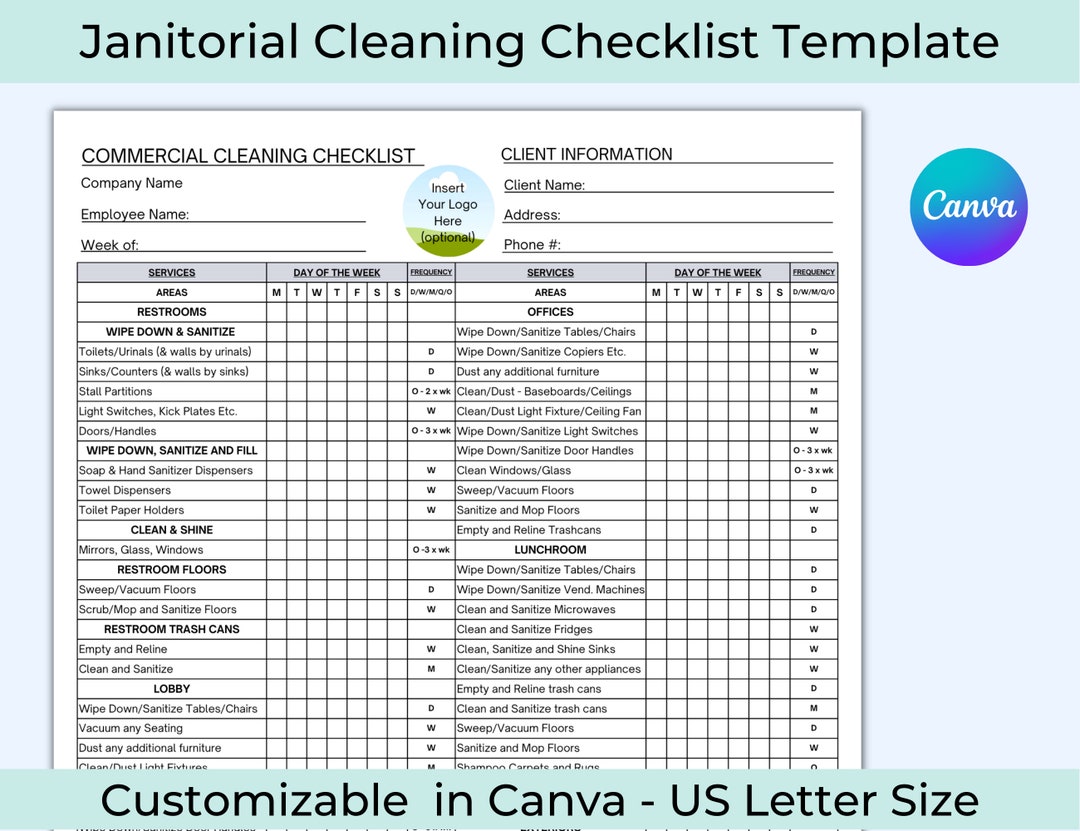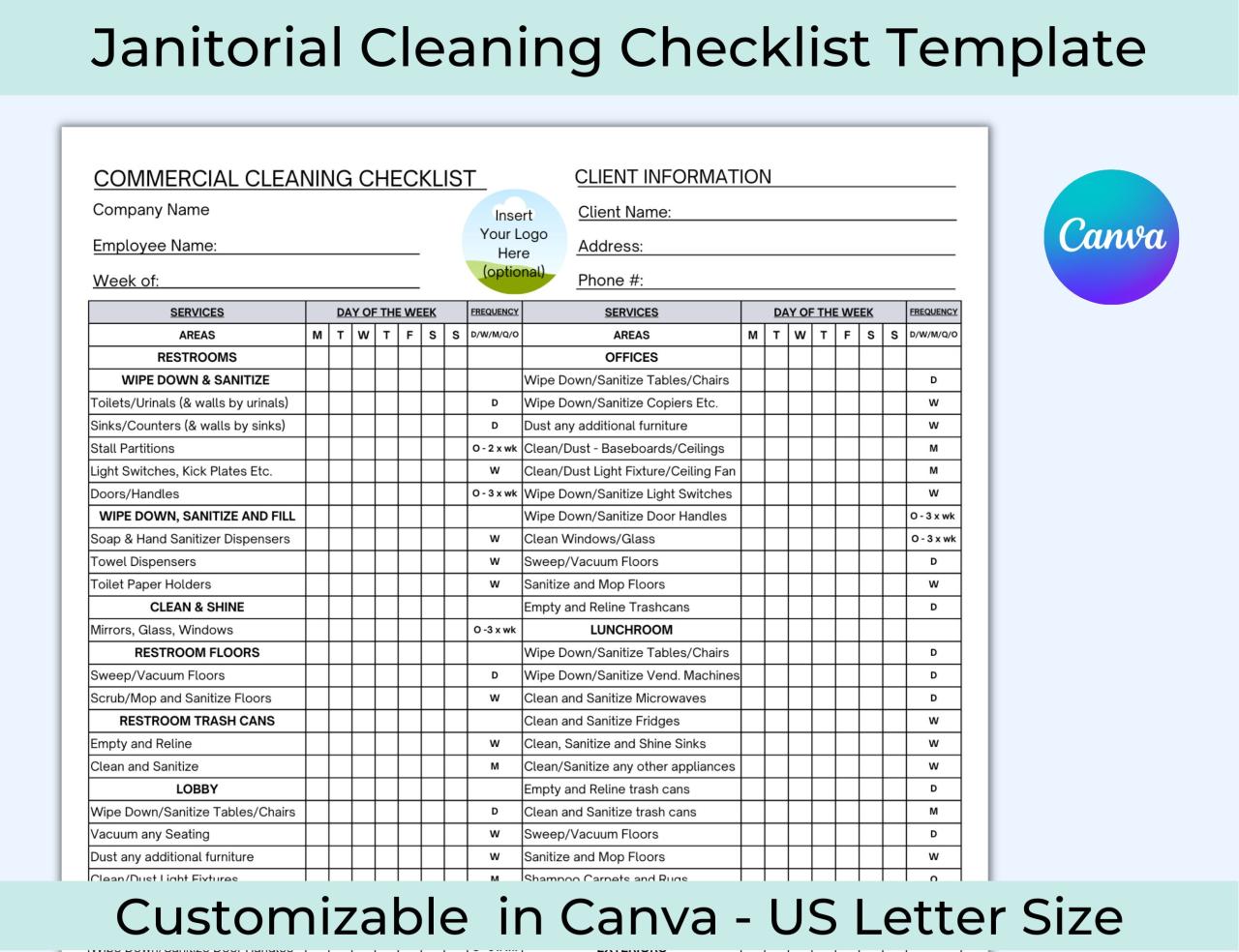Introduction to Commercial Cleaning Free Printable Janitorial Checklist Template
Having a janitorial checklist for commercial cleaning is essential for ensuring that all necessary cleaning tasks are completed efficiently and effectively. It serves as a comprehensive guide that Artikels the specific cleaning tasks that need to be performed in a commercial space.A
printable template can greatly aid in organizing cleaning tasks. It provides a structured format that allows cleaners to easily check off completed tasks and track progress. With a printable template, cleaners can have a clear visual representation of the cleaning tasks that need to be done, making it easier to prioritize and allocate time for each task.Different
types of janitorial checklists can be used in commercial cleaning, depending on the specific needs of the space. Some common examples include:
1. Daily Cleaning Checklist
This checklist includes tasks that need to be performed on a daily basis, such as emptying trash bins, wiping down surfaces, and restocking supplies.
2. Weekly Cleaning Checklist
This checklist includes tasks that should be done on a weekly basis, such as vacuuming carpets, mopping floors, and cleaning windows.
3. Monthly Cleaning Checklist
This checklist includes tasks that are less frequent but still important, such as deep cleaning carpets, polishing furniture, and sanitizing high-touch areas.
4. Seasonal Cleaning Checklist
This checklist includes tasks that are specific to certain seasons, such as cleaning air vents and changing air filters in the spring, or removing snow and ice from entrances in the winter.By using a janitorial checklist template, commercial cleaning teams can ensure that no cleaning task is overlooked or forgotten.
It helps to maintain a consistent level of cleanliness and hygiene in the commercial space, ensuring a safe and pleasant environment for employees and visitors.
Key Components of a Commercial Cleaning Janitorial Checklist Template
Commercial cleaning janitorial checklist templates are essential tools for ensuring that all necessary cleaning tasks are completed efficiently and effectively. These templates help to streamline the cleaning process and ensure that no tasks are overlooked. Here are the key components that should be included in a commercial cleaning janitorial checklist template.
Identify the essential cleaning tasks that should be included in the checklist
When creating a commercial cleaning janitorial checklist template, it is important to identify the essential cleaning tasks that need to be included. This may vary depending on the specific needs of the facility, but some common tasks include:
- Dusting all surfaces, including furniture, shelves, and fixtures
- Vacuuming or sweeping and mopping all floors
- Cleaning and disinfecting restrooms
- Emptying and cleaning trash receptacles
- Wiping down and sanitizing high-touch surfaces, such as door handles and light switches
- Cleaning windows and glass surfaces
- Refilling soap and paper towel dispensers
- Cleaning and organizing common areas, such as lobbies or break rooms
Discuss the importance of prioritizing tasks based on the frequency of cleaning
Prioritizing tasks based on the frequency of cleaning is crucial in maintaining a clean and hygienic environment. Some tasks, such as emptying trash receptacles, may need to be done daily, while others, like cleaning windows, may only need to be done weekly or monthly.
By prioritizing tasks, cleaning staff can ensure that the most critical and time-sensitive tasks are completed first, improving overall efficiency and effectiveness.
Elaborate on the different areas that should be covered in the checklist
A comprehensive commercial cleaning janitorial checklist template should cover all areas of the facility that require cleaning. This includes:
- Restrooms: Cleaning and disinfecting toilets, sinks, mirrors, and floors
- Common areas: Cleaning and organizing lobbies, hallways, break rooms, and waiting areas
- Offices: Dusting furniture, cleaning desks, and emptying trash
- Kitchens: Cleaning appliances, countertops, and sinks
- Conference rooms: Dusting tables, cleaning chairs, and vacuuming floors
- Exterior areas: Sweeping entryways and cleaning outdoor signage
Provide tips on how to categorize tasks in the checklist for easier management
To make managing the cleaning tasks easier, it is helpful to categorize them in the checklist. Here are some tips for categorizing tasks:
- Group similar tasks together, such as all restroom cleaning tasks or all floor cleaning tasks.
- Order tasks based on priority, ensuring that the most important tasks are at the top of the list.
- Consider the time required to complete each task and allocate sufficient time for each category.
- Include any specific instructions or notes for each task to provide clarity to the cleaning staff.
By categorizing tasks in the checklist, cleaning staff can easily navigate through the list and ensure that all necessary tasks are completed in a timely manner.
Designing and Customizing a Commercial Cleaning Janitorial Checklist Template

When designing a commercial cleaning janitorial checklist template, it is important to consider the different formats and layouts that can be used. The checklist should be user-friendly and visually appealing to ensure that it is effective in guiding cleaning tasks.
Additionally, customizing the checklist to fit specific cleaning requirements and preferences is crucial for its successful implementation.
Formats and Layouts
- Simple List: One of the most common formats is a simple list, where cleaning tasks are listed one after another. This format is straightforward and easy to navigate.
- Categorized Checklist: Another option is to categorize cleaning tasks based on different areas or sections of the commercial space. This format allows for a more organized checklist and can help ensure that no tasks are overlooked.
- Interactive Checklist: In today’s digital age, an interactive checklist can be created using software or mobile applications. This format allows for easy customization, tracking, and collaboration among cleaning staff.
Designing a User-Friendly Checklist
- Use Clear and Concise Language: The checklist should be written in simple and easy-to-understand language. Avoid using jargon or technical terms that may confuse the cleaning staff.
- Include Visual Cues: Incorporate visual cues such as icons or images to represent different cleaning tasks. This can make the checklist more visually appealing and help cleaning staff quickly identify tasks.
- Consider Readability: Choose a font and font size that is easy to read. Ensure that there is enough spacing between tasks to avoid clutter and confusion.
- Provide Clear Instructions: For tasks that may require specific instructions or procedures, include detailed information to guide the cleaning staff. This can help prevent errors or misunderstandings.
Customizing the Checklist
- Identify Specific Cleaning Requirements: Before customizing the checklist, it is important to identify the specific cleaning requirements of the commercial space. Consider factors such as the type of flooring, surfaces, and equipment that need to be cleaned.
- Add or Remove Tasks: Based on the identified cleaning requirements, add or remove tasks from the checklist to ensure that it is tailored to the specific needs of the commercial space.
- Adjust Frequency: Determine the frequency at which each task needs to be performed and adjust the checklist accordingly. Some tasks may need to be done daily, while others may be weekly or monthly.
- Include Special Instructions: If there are any special instructions or considerations for certain tasks, make sure to include them in the checklist. This can help ensure that cleaning staff are aware of any specific requirements.
Benefits of Using a Commercial Cleaning Janitorial Checklist Template

Using a commercial cleaning janitorial checklist template can bring several benefits to cleaning operations. Let’s explore some of these benefits below.Checklists can greatly improve the efficiency and effectiveness of cleaning operations. By having a standardized checklist in place, cleaning staff can easily follow a set of tasks and ensure that all necessary cleaning tasks are completed.
This helps to streamline the cleaning process and reduce the chances of tasks being overlooked or forgotten.A commercial cleaning janitorial checklist template also plays a crucial role in ensuring consistent cleaning standards. It provides a clear set of guidelines and expectations for cleaning staff to follow.
This helps to maintain a high level of cleanliness and hygiene throughout the facility, regardless of who is performing the cleaning tasks. Consistent cleaning standards are essential in creating a safe and healthy environment for employees and visitors.Furthermore, a checklist can serve as a valuable tool for monitoring and tracking cleaning tasks.
By documenting completed tasks, supervisors can easily review and assess the quality and timeliness of the cleaning work. This allows for better accountability and enables any issues or deficiencies to be addressed promptly.
Examples of How a Checklist Can Help in Monitoring and Tracking Cleaning Tasks
- A checklist can help ensure that all areas of a facility are regularly cleaned and maintained. By including specific cleaning tasks for each area, such as restrooms, offices, or common areas, cleaning staff can systematically work through the checklist to ensure nothing is missed.
- Checklists can also help in monitoring the frequency of cleaning tasks. For example, if a certain task needs to be done daily, such as emptying trash bins, the checklist can include a column for staff to indicate the date and time the task was completed. This allows supervisors to easily track the completion of daily tasks.
- In the event of an audit or inspection, a checklist can provide a documented record of cleaning tasks performed. This can be valuable in demonstrating compliance with cleaning standards and regulations.
Overall, the use of a commercial cleaning janitorial checklist template can greatly enhance the efficiency, effectiveness, and consistency of cleaning operations. It serves as a valuable tool for both cleaning staff and supervisors in ensuring a clean and well-maintained facility.
Tips for Implementing and Maintaining a Commercial Cleaning Janitorial Checklist Template
Implementing and maintaining a commercial cleaning janitorial checklist template is crucial for ensuring that cleaning tasks are carried out efficiently and consistently. Here are some tips to help you effectively utilize and update your checklist.
Training Staff on Using the Checklist Effectively
To ensure that your staff members are using the checklist correctly, it is important to provide thorough training. Here are some tips to consider:
- Explain the purpose and importance of the checklist. Emphasize how it helps ensure that all cleaning tasks are completed and maintains a high standard of cleanliness.
- Walk through each item on the checklist and demonstrate how to properly complete the tasks associated with them.
- Provide written instructions or guidelines for each task to serve as a reference for your staff members.
- Offer hands-on practice and provide constructive feedback to help staff members familiarize themselves with the checklist.
Integrating the Checklist into Daily Cleaning Routines
To maximize the effectiveness of your janitorial checklist, it is important to integrate it seamlessly into your daily cleaning routines. Consider the following tips:
- Assign specific tasks to each staff member and ensure they have access to the checklist relevant to their responsibilities.
- Set a schedule for completing tasks and incorporate the checklist into your staff members’ daily work routines.
- Encourage staff members to check off tasks as they are completed to track progress and ensure nothing is overlooked.
- Regularly review the checklist with your staff members to address any questions or concerns and provide support.
Regularly Reviewing and Updating the Checklist
To keep your commercial cleaning janitorial checklist template effective, it is important to regularly review and update it to meet changing needs. Here are some suggestions:
- Set a schedule for reviewing and updating the checklist, such as quarterly or annually.
- Seek feedback from your staff members on any tasks that may need to be added, removed, or modified.
- Consider industry standards, regulations, and best practices when updating the checklist.
- Ensure that the checklist reflects any changes in cleaning products, equipment, or procedures.
By training your staff members on using the checklist effectively, integrating it into daily cleaning routines, and regularly reviewing and updating it, you can ensure that your commercial cleaning operations are efficient, consistent, and meet the changing needs of your facility.
